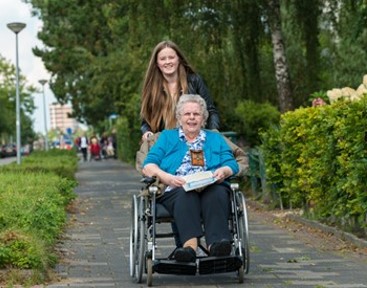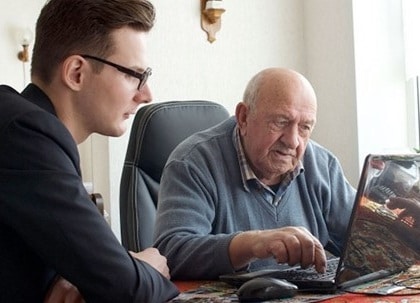Intergenerational Housing – Why?
ramaker insights
intergenerational housing – why?
ramaker insights
a brief discussion with ramaker’s joe gallagher
Recently, Designer Joe Gallagher joined the RAMAKER team, bringing with him years of personal research and expertise in the concept of Intergenerational Housing. He’s spoken at numerous conferences in Wisconsin as well as participated in round table discussions in both Wisconsin and Pennsylvania – where he is originally from. He has written about the housing typology in the past, along with updates on his findings – something he looks to continue while here at RAMAKER. We sat down with him to discuss his views on Intergenerational Housing currently, as a potential solution to many issues we see here in Wisconsin, from Affordable housing, to workforce shortages and even childcare shortages:

FIRST AND FOREMOST, WHAT EXACTLY IS “INTERGENERATIONAL HOUSING”?
 Joe: I use this definition to begin pretty much all my discussions on the topic; I see Intergenerational housing as a community typology that is designed to provide a lifestyle that intertwines recreational, educational and social activities and opportunities amongst individuals across different generations.
Joe: I use this definition to begin pretty much all my discussions on the topic; I see Intergenerational housing as a community typology that is designed to provide a lifestyle that intertwines recreational, educational and social activities and opportunities amongst individuals across different generations.
WHERE/WHEN DID YOU LEARN OF INTERGENERATIONAL HOUSING?
Joe: This is an interesting one; during my sophomore year of my undergraduate studies, I actually had hopes of getting into a hospitality-based studio course, but unfortunately it had filled up (or I guess, fortunately in this case!). I ended up partaking in a design studio around designing for individuals with Alzheimer’s. Up until that point, I thought of design as universal, with endless combinations of spatial layouts, interiors palettes and overall forms of buildings. Learning about the progression of the various stages of memory loss and the inevitable effects on an individual’s day-to-day life, truly opened my eyes to seeing ALL design differently. And not just memory loss, but simply aging in-place, limitations in abilities as one gets older, things like that.
Over the years, I watched a family member progress through the stages of memory loss, and as she slowly became unable to remember things or had trouble accomplishing routine daily tasks, we adjusted and helped her as best we could so that she could stay in her home. It made me start to selfishly think – what will happen to ME as I get older? Will my children take care of me? Will I end up in some sort of assisted care community? Would that be a bad thing?
In many countries, the children and grandchildren take care of the elders at home; but very rarely do we see that here in the US. The 55+ independent community model has been growing significantly nationwide in recent years, as the baby boomers start to become empty-nesters and downsize from family homes. While these models allow for an independent lifestyle, they also inevitably create a concentrated community of residents who will age together and at some point, either require some sort of assistance or potentially need to leave the communities they were initially drawn to.
This overall thought process, combined with my undergraduate experiences, led me to begin researching other housing typologies that could address these concerns. I was initially led to work being done in the Netherlands and Germany. The Netherlands are where the concept of Assisted Living was originally created. But these countries were taking the idea even further – the ‘assistance’ was being provided by regular, everyday citizens. Communities were being created where an individual willing to assist others in routine daily tasks – cooking, cleaning, laundry, grocery shopping – would receive reduced rents or sometimes even free rent within the community, in exchange for their time. This concept of live-in assistance throughout the community was something that could easily be marketed to their aging populations, while not requiring that feel of being in a nursing home setting. Let’s just say – IT WORKED…VERY WELL.
WHAT DO YOU MEAN BY ‘IT WORKED’? DON’T LEAVE US HANGING!
 Joe: Okay, okay – Basically the Netherlands have established entire communities based off this ideology. One case study I always mention is Humanitas in Deventer, Netherlands. Humanitas is a social services organization in the Netherlands that was founded in 1945 and has since grown to 80 chapters nationwide. The most amazing statistic of the organization is that they support more than 65,000 residents across the country with a ‘staff’ of only 300 people (yes that would be a 1:217 ratio!). However, the organization has 24,000+ volunteers or ‘buddies’ nationwide as well.
Joe: Okay, okay – Basically the Netherlands have established entire communities based off this ideology. One case study I always mention is Humanitas in Deventer, Netherlands. Humanitas is a social services organization in the Netherlands that was founded in 1945 and has since grown to 80 chapters nationwide. The most amazing statistic of the organization is that they support more than 65,000 residents across the country with a ‘staff’ of only 300 people (yes that would be a 1:217 ratio!). However, the organization has 24,000+ volunteers or ‘buddies’ nationwide as well.
Basically, what happened was back in 2012, a student at local university contacted one of Humanitas’s locations in Deventer. At the time, the city was dealing with a housing shortage which also indirectly affected student housing for the university. The student – Otto Selbach – inquired about renting a room in one of the senior communities. He offered to aid residents in the community, doing remedial tasks in exchange for a cheaper rent at the facility. He and facility director Gea Sijpkes realized that this was not only a great idea – this would greatly benefit the community, as they needed additional staff. Thus, the idea was born.
Today, the organization operates communities nationwide in which students and young professionals can live (rent-free) in exchange for providing “Good Neighbor” services to residents of the community. Not only are they able to assist the seniors with every day, remedial tasks, but they also teach them skills such as email, social media, how to Skype with loved ones, and most importantly – they provide companionship. Social isolation is one of the leading causes of decline in the health of seniors. The students and young professionals keep the seniors engaged with the outside world, through the sharing of stories – from classes, to parties, to nights out on the town – the seniors get to live through the younger residents. The social & health benefits of the living arrangement far surpass anything that could be imagined!
THE IDEA OF INTERGENERATIONAL COMMUNITIES SEEMS TO OFFER SO MANY BENEFITS – WHY AREN’T WE SEEING MORE OF THIS IN THE U.S.?
Joe: I think we will start to see the concept slowly make its way throughout the country over the next 5-10 years. I think it MUST. For some reason, as a society we thought it was a good idea to bring seniors together into concentrated and often isolated communities. Ideally, it was the thought of having the assistance and care one needed, closely located but available for all members of the community. The problem with this concept is that we unintentionally began increasing social isolation in a population of individuals who were already coping with aging. The mental health decline that comes with the realization that you are no longer the young, energetic person of your prime, compounded by being removed from the general public who still ARE energetic and in their prime and replacing that group with other seniors who are also on the back-end of their lives – is a blunt perspective and realization of what stress we’ve unintentionally placed on our loved ones.
With the baby boomers retiring or getting close to retirement age, we’re seeing a trend of long-time home owners looking to downsize into smaller condos or apartments, with ease of access to local amenities and a high priority placed on walkability. Ironically, that thought process is also similar to that of the millennial and younger generations – condos or apartments close to downtown or in walkable areas with activities and amenities nearby. We have two large generations of the population who are looking for the same lifestyle. The only difference (albeit big) is age.
The traditional way of planning – moving seniors into communities away from the downtown and active spaces – will need to be undone or reconsidered. Further, currently in the state of Wisconsin we are seeing workforce shortages in the senior care markets. In fact, we’re starting to reach a nationwide crisis in the assisted care realm. It will only continue to get worse as the baby boomers slowly leave the workforce. Introducing a living arrangement where these students and younger professionals could assist their neighbors in remedial tasks, in exchange for a lower rent while the seniors maybe pay a slightly higher rent (albeit nowhere near the costs of assisted living) would allow for more seniors to continue enjoying their independence and stay more involved with the local communities. And if that isn’t enough, seniors LOVE children right? We can work to create daycare opportunities for retired seniors to watch residents’ children during the day – hey there are such things as rent-a-nanny services! Again, we are facing a childcare shortage in Wisconsin as well – combined with soaring childcare costs (last research I did showed Wisconsin as being the 4th most expensive state for childcare services for children 0-3 years…).
IN GENERAL, IT SEEMS THE CONCEPT REALLY BENEFITS ALL PARTIES INVOLVED; DO YOU AGREE?
Joe: For sure, I think that the outcomes have been mutually beneficial to all parties involved: the seniors, the students & younger professionals, and the communities themselves. As I mentioned, there’s a been a ton of research done on social isolation and loneliness in seniors and its association with mental decline and increased mortality. These areas are immediately eliminated when you introduce younger generations to the equation – social engagement levels drastically increase, leading to a much healthier lifestyle. For the students & younger professionals, they learn numerous life skills and responsibilities by helping taking care of someone. And patience – believe me, patience is something that can and will be learned! Once we can remove that odd stigma surrounding “old people” and start to embrace aging as a positive thing, we will start to see changes in all generations.
That leads me to the benefits to the communities and facilities themselves. In the Netherlands and Germany, these Intergenerational communities began as a housing option for students – that truly was the initial benefit to the participators. However, as they progressed, many students wanted to come back for additional semesters, to continue supporting the residents. In some cases, they ultimately took full-time positions within the organization following school. At a time in Wisconsin, and even nationwide, where senior care workforce shortages are at their highest numbers, this growth within the skilled care workforce by ‘chance’ is one that should be looked to as an opportunity here in the US. Many of the students who volunteered or applied to these programs, had no prior experience or interest in senior care. It was honestly just a free place to live. But it was overwhelmingly surprising how many of those students continued forward in their lives, pursuing careers in skilled care and gerontology related fields.
SO THEN, THE ULTIMATE QUESTION: HOW DO WE BRING INTERGENERATIONAL HOUSING TO WISCONSIN?
Joe: Well I think there are two main solutions. The first – we basically develop these communities in a manner which is based on what I have outlined prior as being the foundations of Intergenerational Housing. Pretty simple, right? All kidding aside though (solution 2), I think the easiest plan of action would be to encourage current facility operators to consider this community typology, and look internally at their current resources: staff, residents, available rooms/beds. Consider establishing partnerships with nearby colleges or universities, to create clinical rotations with a live-in component, or merely just offer up some rooms for students to live at a reduced rate in exchange for remedial services. I truly believe that the additional assistance will reduce the burn-out rate on CNA’s statewide.
Honestly, I have a whole list of ideas on how the living arrangements could work, as well for future engagements that will require collaboration between local communities, universities, spatial planners/designers and of course local governments. I am more than happy to further elaborate on anything I’ve chatted about here, or to assist with design or organizational endeavors of local communities. To anyone perusing this, please don’t hesitate to reach out to me via email!
Also, to everyone who has been following me on this journey thus far, the blog posts will begin soon, and you should be seeing some email update(s) in the weeks to come! To anyone new who is interested in being added to my email list with regards to my research, findings, upcoming speaking engagements (or just to see the cute pictures of my dogs I put on each one), feel free to reach out as well and I will get you added! Thank you!
about joe gallagher
Originally from just outside of Philadelphia, PA, Joe graduated from Temple University with a Master’s degree in Architecture. He and his wife Chelsea relocated to the Madison area in August 2016. Senior Living design is something that he has always been passionate about. His goal is to enhance collaboration between designers and senior care providers as well as the communities in which they serve, to rethink the senior living industry. He is also interested in hospitality & bar/restaurant design as well, having completed numerous projects since moving to WI. He is an avid Philadelphia sports fan as well as supports his Temple Owls! #FlyEaglesFly



